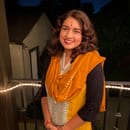I always liked trinkets and small, shiny things as a kid, mainly because I liked to stick them in my pockets and pretend they were time turners, or the one ring, or, in the case of one especially pretty compact mirror, the golden compass. I was too young to really have much of my own though, so I’d crow with fascination whenever my mother got ready for nights out. Not the ordinary restaurant dinners and dinner parties with other moms from my school. No, I liked when she got ready for weddings or Diwali parties, any kind of occasion that meant she’d pull out her saris or kurtis.
Indian outfits meant the jewelry would come not from the selection of necklaces draped on her mirror, but from the brown leather case with the button clasp that lived safely at the bottom shelf of her wardrobe. I never got tired of seeing the velvet-lined case with all its neat little compartments and pouches, my mother’s collection artfully arranged among them. Earrings nestled in pairs, bracelets and necklaces carefully laid out in button-down pockets to resist tangling.
And each piece held its own story.
“Where did you get these?” I would ask, wide-eyed, pointing at a cluster of pearls, a ring with a real ruby in it, a gold chain. Indian jewelry didn’t look like the assortment of simple chains and shaped pendants I was used to. There were tikas – pendants hanging on single chains, designed to be clipped into the part of your hair and dangle onto your forehead – chooris – stacks of glittering colorful bangles my sister and I would be allowed to choose to match our outfits, delighting in the way they jangled up and down our arms, bindis – colorful little dots to be placed in the middle of our foreheads to complete any Indian outfits. “These are atheroos,” my mother explained to me about a pair of earrings from which long chains draped almost to her shoulders. “Only married women wear them.” They were traditional pieces of jewelry from Kashmir, where my father’s family was from.
I had never been to Kashmir at that point in my life; my father’s family hadn’t lived there, or even been able to visit in generations due to unrest in the region. It was a homeland I would never know, roots I could never touch. But these earrings that my mother had received when she was married meant I could watch, in the familiarity of her bedroom, as she donned the same jewelry for the same occasions my great-grandmothers might have, half a world away. Sometimes she would fasten a parandhi – an ornament for women’s braids from her own family’s homeland, Punjab – into my younger sister’s long hair. Neither my sister nor I had ever been to Punjab either; the language was as unfamiliar to us as Kashmiri. But here was a piece of our heritage we could hold and touch and carry with us, a tether to ensure we could feel a homeland we’d never known.
“I’ll pass these on to you two someday,” my mother often says of the pieces we admire. We joke around sometimes, my sister and I bickering about who should get what in the inheritance. But there is a kind of reverence that exists in knowing no matter how different our lives may look from our mothers, grandmothers, and ancestors, we have something tangible to hold onto, and use as they might have.
I’m old enough now that I’m allowed to borrow my mum’s pieces sometimes. Indian events mean I still need her help getting ready half the time – I can’t drape a sari by myself, and she’s much better at placing bindis on my forehead than I am – and I’m still as fascinated as ever when she brings her jewelry box out. They’re only trinkets, far from the most valuable thing my culture and heritage has given me, but I love them nonetheless. Each bauble has a story to tell, whether simply because the design is one unique to India, or because someone special once wore it and passed it on.
I look at these pieces of jewelry and I see stories. I know some by heart now, and I know I’ll learn the rest someday. Some might even have stories I’ll one day be a part of.


